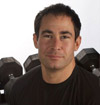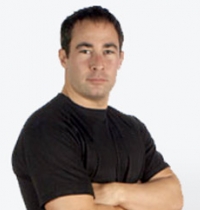Train Muscles NOT Movements!

ALSO CHECK OUT: Arnold's Epic Giveaway! Win a personalized voicemail message by Arnold!

By Nick Tumminello
For several years now, many people in the fitness field have loved throwing out the blanket statement of, “Train movements, not muscles,” in order to direct people away from the bodybuilding style (body-part) training approach. Although we at Performance U appreciate this advice for athletes whose primary goal is sports performance (i.e. movement) related – We feel this recommendation is off base for individuals who’s goal is bodybuilding oriented!
In other words, if your primary training goal is to GET BIGGER muscles (i.e. increase hypertrophy), we’ve found it’s best to focus on training MUSCLES, not movements because your goal is about muscles: bigger shoulders & chest, wider lats, harder butt, etc. And, we’re sure that just about anyone who’s ever done an amateur or pro figure, physique or bodybuilding competition has found the same!
Bodybuilding IS Functional Training!
For example: Squats, deadlifts and lunges! These are all corner-stone exercise in both bodybuilding and sports (functional) strength programs. The same goes for upper-body training! Let’s take overhead presses and bench press variations, which are exercises regularly used in bodybuilding, strength and functional performance training programs. The sports strength coach may call these upper-body moves, horizontal andvertical pushing exercises, whereas the bodybuilding enthusiast might call it chest and shoulders training. We really don’t care what you call it because it’s the same damn stuff!
What about isolation exercises? That’s the difference between bodybuilding (muscle) training and functional (movement) training workouts. Right? Well… even those who love to say, “train movements, not muscles” completely contradict themselves and target body parts in their programs.
For instance: Core training! Many trainers and coaches dedicate a specific part of their workout (either at the beginning or at the end) to use specific “core” training exercises. The question is: What movement is “core”? The answer, of course is: the “core” is NOT a movement; it’s a muscle group! And, now we’re back to training muscles, not movements, which is no different than dedicating special time in your workouts (either at the beginning or at the end) to train the shoulders, which are also a very important muscle group!
Another unconscious contradiction to the “movement, not muscles” philosophy comes in the form of “Muscle activation” exercises. These exercises are used to specifically target (i.e. isolate) and “activate” muscles like the glutes and middle traps. An example of a middle trapezius “activation” exercise is shoulder T’s. The interesting thing is: T’s are virtually the same exercise movement as a rear-delt fly, which the same trainers would deem as a non-functional, bodybuilding (muscle) training exercise.
Muscles CREATE movements!
In truth, ALL exercises are movement exercises. In fact, that’s what the nature of exercise is: moving your body!
Lets take two common bodybuilding (isolation) exercises: The dumbbell side shoulder raise and the biceps curl. The lateral raise involves (and strengthens) the movement of shoulder abduction and a dumbbell biceps curl strengthens the movement of elbow flexion.
Now, if you’re into the “movements, not muscles” thought process, then you may be more comfortable calling lateral raises, ”shoulder abduction pattern training”, or as a “delt-muscle activation” exercise. And, you may prefer to classify biceps curls as “elbow flexion movement training” or “elbow dominant training” as some strength coaches like to classify exercises like lunges and squats as “knee dominant training.” Whatever you decide to label these exercises, there’s nothing “non-functional” about improving your ability of your shoulders and biceps MUSCLES to perform the MOVEMENTS of bending your elbows and lifting your arms up!
Train on Principles NOT Philosophies
The biggest reason we recommend focusing on training muscles not movements (i.e. taking a body-part split approach), for the goal of gaining muscle size, is because that’s what the PRINCIPLES of structural hypertrophy training dictate.
In other words, we don’t determine our workout programs by trying to honor some particular training philosophy. Instead, we design our workout programs based on proven, universal training principles.
You see… the saying; “train movements, not muscles” represents one particular training philosophy… no different than an Olympic lifting philosophy or a Powerlifting philosophy. All of these approaches to training are great! But, the thing is; different approaches work best for certain goals. And, NO one approach works for all goals. This is why, unlike many trainers & coaches, we don’t marry ourselves to any one particular training approach. Instead, we remain versatile and are much better able choose the best training approach to fit each individual goal instead of trying to force every person into our chosen method.
When we look at the PRINCIPLES behind hypertrophy training, we find they guide us toward a bodybuilding (i.e. muscles) training approach over other methods.
It’s beyond the scope of this article to cover all of the bodybuilding principles we follow. But, here are three key (muscle oriented) principles in effective Hypertrophy training, which we’ve used to successfully help a wide variety of individuals (male & female) gain muscle size as fast a humanly possible:
1. Muscle Targeting (aka. Isolation training) – We strongly believe that some extra isolation work is needed to “bring up” your weaker, less-developed body-parts.
A good example of a muscles group that can really benefit from specific (isolation) work is the Hamstrings.
According to hypertrophy training expert Brad Schoenfeld, “The hamstrings don’t change length when performing standard compound exercises like squats and lunges because as you bend at your hips, you’re also bending at your knees, The resultant of those two joint actions is no (or minimal) length change of the hamstrings.”
Since the many of the standard compound lower-body moves don’t create enough physiological load on the hamstrings - in order to stimulate muscle growth, using some targeted (isolation) hamstring exercises can be a great way to overload them.
This is also critical point for females looking to build better-looking (and stronger) hamstrings… as it’s well established that females are more quad-dominant than males. If a female only sticks to compound lower-body (movement) exercises and neglects to also utilize some hamstring isolation work, she would most likely feed into a muscle imbalance where she continually built bigger and stronger quads with weaker and less developed hamstrings. This muscle imbalance is not only less aesthetically pleasing; it can place female athletes at a higher risk of injury.
2. The Pump and Mental Muscle Focus – We all know Arnold's famous line in Pumping Iron about the pump. Well, whether you enjoy the feeling of the muscle pump or not, it has been linked in the research to aiding in hypertrophy (i.e. muscle growth) through “cell swelling.”
Now, it’s no secret that you get a much better pump from more targeted exercises, whereas compound (movement) exercises just tend to make you feel overall fatigued. So, adding in some muscle pump work along with compound movements can absolutely accelerate your muscle gains.
Additionally, lets not forget another classic bodybuilding (muscle) training tip about squeezing your muscles during the exercise. According to Bret Contreras & Brad Schoenfeld, “simply concentrating on the target musculature resulted (according to EMG research) in greater activation of this muscle.“
In other words, if you mind your muscle, it matters! And, it’s pretty tough (more like impossible) to increase your mind to muscle connection to a particular muscle group when all you’re doing are total-body (movement) training exercises.
3. Total Sets per body part per week - According to NSCA Board of directors member: Juan Carlos Santana, it requires “12-20 sets per week/per body part, at an average of 8-15 reps per set” to provide an effective stimulus to increase muscle growth.” We’ll add that this recommendation is for individuals who have already established (at least) 4+ weeks of a strength-training base.
Now, let’s apply this to real-world training: if you want to increase the size of (let’s say) your shoulders, chest and lats; you must perform at least 12 sets for EACH of those body-parts, per week to accumulate the kind of work volume need to stimulate optimal muscle growth (i.e. size gains). And, the more trained you are, the more volume you’ll need each week!
Keep in mind that a vertical pressing exercise (like overhead presses) is a more of a shoulder movement, while a horizontal pressing exercise (like bench press) is more chest muscle oriented. So, if you followed a movements (not muscles) approach to your upper-body strength training and only did 4 sets of each (vertical & horizontal) pushing movement once per week, you’d only have done 4 sets per muscle group (4 sets shoulders and 4 set for chest). If you did them twice per week, you’d still only have accumulated 8 sets per muscle group, which is STILL not enough training stimulus (i.e. volume) to push muscle growth into high-gear. Not to mention you’re not even mixing up exercises to hit those muscles from different angles in order to create training variety and minimize risk of a pattern overload related injury.
Who would have thought that a bodybuilding approach is great for a bodybuilding-oriented goal? It’s common sense and just so simple, we guess it’s too simple to be sexy, seeing as how we have a fitness industry that’s riddled with gurus and followers willing to pledge their allegiance and continue to fantasize about how their particular chosen training method “does it all!”
Training Movements AND Muscles!
Let’s say your training goal is to get a bit more HUSTLE (i.e. better movement) and more MUSCLE (i.e. get bigger). That’s a mutli-dimensional goal, which requires a multi-dimension approach. DUH!
So, you simply train movement AND muscles. That’s what we call “Hybrid training,” baby! You do some integrated (movement) training stuff and you also do some bodybuilding stuff. DUH! But, don’t jumble those two concepts together in a circuit! Instead, respect each method as it’s own stand-alone activity and you’ll get better benefits. As the saying goes, “if you chase two rabbits, you’ll never catch either.”
Lastly, the best MOVEMENT training is not done with gym-oriented exercises – It’s done during play and during sports. So, if you really want to do MOVEMENT training, take up a sport (or even a few) and go outside and play like you did when you were a kid! Then, complement those activities with good old weight training!
ALSO CHECK OUT: Arnold's Epic Giveaway! Win a personalized voicemail message by Arnold!
ABOUT THE AUTHOR

Coach Nick Tumminello has become known as “the trainer of trainers.” He’s the owner of owner of Performance University International, which provides practical, No B.S., personal trainer continuing education.
Nick lives in Fort Lauderdale Florida were he trains a select group of clients and teaches mentorships. Check out his DVDs, seminar schedule and very popular hybrid fitness training blog.
Website: http://nicktumminello.com
